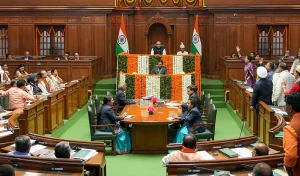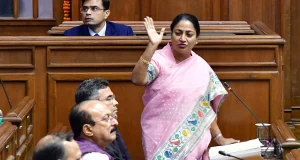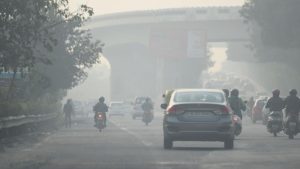New Delhi – The Delhi Assembly is set to receive a crucial report from the Comptroller and Auditor General (CAG) detailing the severe financial losses suffered by the Delhi Transport Corporation (DTC) and the growing concerns over air pollution linked to the transport sector. The CAG Report on Vehicle Pollution is expected to highlight inefficiencies in fleet management, infrastructure shortcomings, and the pressing need for strategic interventions to enhance public transport while mitigating environmental impacts.

Financial Burden on Delhi Transport Corporation
The CAG Report on Vehicle Pollution has revealed alarming financial data concerning the DTC, highlighting its declining economic health over the past few years. Between the fiscal years 2015-16 and 2021-22, the corporation’s liabilities surged dramatically from ₹28,263 crore to ₹65,274 crore. This sharp increase in liabilities reflects poor financial management and an urgent need for policy-level interventions.
During the same period, DTC incurred operational losses exceeding ₹14,000 crore. These losses stem from multiple operational inefficiencies, including revenue shortfalls, rising operational costs, and the mismanagement of assets. The financial burden has led to a shrinking fleet and deteriorating service quality, significantly impacting public transportation in Delhi.
Challenges in Fleet Management and Operations
A critical aspect of the CAG Report on Vehicle Pollution focuses on fleet management and the operational inefficiencies plaguing the DTC. As of March 31, 2023, nearly 45% of the corporation’s low-floor buses were classified as overaged, indicating a lack of timely fleet renewal and modernization efforts.
In addition to aging buses, procurement delays have further exacerbated DTC’s woes. The corporation reportedly failed to impose penalties amounting to ₹29.86 crore for delays in the supply of electric buses. These inefficiencies have prevented the timely expansion and improvement of the public transport network.
Another major concern outlined in the CAG Report on Vehicle Pollution is that DTC buses operate on only 57% of designated routes. The lack of route optimization has resulted in reduced coverage, forcing commuters to rely on alternative, often more polluting, modes of transportation. Addressing this issue is crucial to improving service efficiency and reducing congestion on roads.
Infrastructure and Technology Deficiencies
The CAG Report on Vehicle Pollution also sheds light on major infrastructure and technological shortcomings that have hindered the efficiency of the Delhi Transport Corporation.
One of the most glaring issues highlighted in the CAG Report on Vehicle Pollution is the failure to operationalize CCTV surveillance systems in buses. Despite the installation of CCTV cameras in 3,697 buses in March 2021, these systems remained non-functional as of May 2023. The Delhi government had already released a payment of ₹52.45 crore to the contractor, yet the systems could not be declared operational due to pending user acceptance tests. This delay not only reflects inefficiency but also raises concerns about commuter safety.
Another significant lapse in management is the absence of strategic planning. The CAG Report on Vehicle Pollution indicates that the DTC has not prepared any business or perspective plans to mitigate financial losses. Furthermore, the corporation has failed to set physical and financial targets for operational efficiency. The lack of benchmarking against other state transport undertakings has further hampered efforts to enhance performance.
Also Read: PM Modi Chhattisgarh Development Projects: Rs. 33,700 Cr Boost in Growth
Political Response and Accountability Measures
The release of the CAG Report on Vehicle Pollution has triggered a strong political response, with leaders emphasizing the need for reforms and greater accountability in the management of the DTC. Delhi Chief Minister Rekha Gupta has expressed serious concerns over the corporation’s financial instability and operational inefficiencies. She pointed out that under the previous administration, the DTC suffered a cumulative loss of ₹70,471 crore, with operational losses alone accounting for ₹14,198 crore.


To address these concerns, CM Gupta has proposed referring the CAG report to the Public Accounts Committee (PAC). This move aims to ensure a thorough investigation into the findings and recommend corrective measures to improve DTC’s financial and operational framework.
Air Pollution and Environmental Implications


Beyond financial and operational concerns, the transport sector remains a significant contributor to Delhi’s air pollution crisis. The forthcoming CAG Report on Vehicle Pollution is expected to provide a detailed assessment of the environmental impact of the city’s transport policies.
Delhi has been struggling with deteriorating air quality for years, with vehicular emissions being a major factor. The slow transition to electric buses and the inefficiency of the existing public transport system have compounded the pollution problem. Strengthening public transportation infrastructure and promoting cleaner energy alternatives are key to reducing emissions and improving air quality.
Strategies for Revitalizing Delhi Transport Corporation
The challenges outlined in the CAG Report on Vehicle Pollution, call for urgent and comprehensive solutions. The following strategic interventions are essential to revitalizing the DTC and addressing its financial and environmental concerns:
- Fleet Modernization: Accelerate the procurement and deployment of new, environmentally friendly buses to replace aging vehicles. This will enhance service reliability and contribute to lower emissions.
- Operational Optimization: Improve route planning and scheduling to ensure better service coverage and increased revenue generation. Addressing route inefficiencies will also help reduce congestion and travel times.
- Technology Integration: Ensure that all installed technologies, such as CCTV cameras, are fully operational. Strengthening digital monitoring systems can enhance passenger safety and operational transparency.
- Strategic Financial Planning: Develop a long-term financial plan with clear revenue targets and cost-cutting strategies. Implementing strict financial discipline is necessary to prevent further losses.
- Environmental Sustainability Initiatives: Prioritize the transition to electric and hybrid buses. Investing in eco-friendly infrastructure will not only improve air quality but also position Delhi as a leader in sustainable urban transportation.
Conclusion
The CAG Report on Vehicle Pollution serves as a crucial wake-up call for the Delhi residents and the government including the transport authorities as well. Addressing the financial mismanagement and operational inefficiencies within the Delhi Transport Corporation is imperative to restoring the credibility of the city’s public transport system. Simultaneously, tackling the environmental impact of vehicular emissions should remain a top priority.
By implementing strategic interventions that focus on modernization, efficiency, and sustainability, Delhi can create a resilient and environmentally friendly transport network. These reforms will ultimately benefit millions of commuters and contribute to improved air quality, making Delhi a cleaner and more efficient city for future generations.

